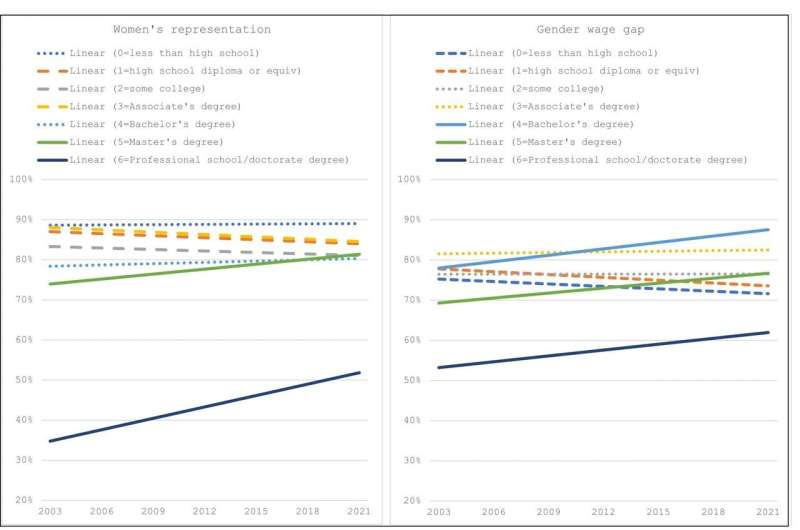This article has been reviewed according to Science X's editorial process and policies. Editors have highlighted the following attributes while ensuring the content's credibility:
fact-checked
trusted source
proofread
Gender wage gaps persist among health care workers

Though women perform 77% of health care jobs nationally, gender wage gaps persist, potentially contributing to lower lifetime earnings for millions of women and deterring professional advancement.
Recent research on the health care wage gap has focused primarily on physicians and other workers with high levels of training and education, but few studies have examined the gender wage gap comprehensively across the health care workforce, especially among workers with an associate's degree or less.
Furthermore, little research has been conducted on how the gender wage gap changed over the last two decades relative to women's representation in health care occupations.
A new study from the University of Minnesota School of Public Health (SPH) addressed this topic by examining data gathered between 2003 and 2021 to see how the gender wage gap within various health care fields changed over the last two decades. The study, published in Health Affairs Scholar, found:
- Women's representation increased in health care occupations that require a master's or doctoral/professional degree—8% in positions requiring a master's degree and 42% in positions at the doctorate/professional level. At the bachelor's degree level, growth was stagnant (0% change).
- Men's representation increased slightly in nursing occupations like registered nurses and licensed practical nurses. The adjusted wage gap between women and men is the largest among workers in high-education health care fields like physicians and other advanced practitioners.
- In 2021, the gender wage gap was the lowest among workers with a bachelor's degree (88%), followed by those with an associate's degree (82%), some college (77%), master's degree (77%), high school degree (72%), less than high school (71%) and professional school/doctorate degree (61%).
- The gender wage gap has stagnated or grown larger in some lower-education occupations, where men's percentage of the workforce has increased.
"Health care is a woman-dominated industry and should be a leading field in promoting gender wage equality," said Janette Dill, an associate professor at SPH and lead author. "The good news is women's representation in health care occupations increased to a greater degree in high-education occupations," Dill said.
"We also found the gender wage gap remains larger in high-education occupations compared to lower-education health care occupations—meaning women with several years of education and training are earning a fraction of what their male counterparts are making."
The researchers include a number of policy suggestions, including gender equity reviews within health care organizations, prioritizing female managers and realigning Medicare and Medicaid reimbursement policies to promote greater gender equity within and across health care occupations.
More information: Janette S Dill et al, The gender wage gap among health care workers across educational and occupational groups, Health Affairs Scholar (2023). DOI: 10.1093/haschl/qxad090





















